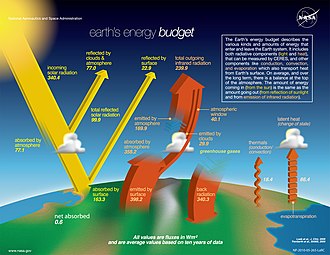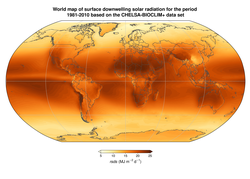Insolation

Insolation is derived from the words "incoming solar radiation". Insolation is specifically applied to radiation which is arriving at earth’s atmosphere first and then earth's surface. The heat comes from solar energy. Insolation is the solar radiation that reaches the earth's surface. It is measured by the amount of solar energy received per square centimetre per minute. Solar energy received over the planet’s surface varies according to season, latitude, transparency of the atmosphere, and aspect , ground slope and albedo effect .
Insolation affects temperature. The more the insolation, the higher the temperature.
In any given day, the strongest insolation is received at noon.
Factors influencing insolation
The amount of insolation received on the earth’s surface is not the same everywhere. It varies according to the place and time. Tropical regions get the most insolation, it gradually decreases towards the poles. Insolation happens more in summers and less in winters. The major factors which influence the amount of insolation received are:
- Solar constant
- The angle of incidence of the sun’s rays
- Duration of the day
- Earth distance from Sun
- Transparency of the atmosphere
Solar Constant
At the top of the earth’s atmosphere, received insolation is expressed as the solar constant. It receives at the top of the atmospheric surface (thermopause) on a perpendicular plane to the solar beam. The average insolation received at the thermopause i.e.1368Wm2 (Watt per squaremetre) energy(solar constant) is in the form of short wave. Thus, it is termed as solar constant for that mean distance from the sun. These solar constant is varying over 1 Wm2 by periodic disturbances and explosions in the solar surface basically related to sun spot. Sun spots are dark and cooler areas visible on the sun’s surface. The recent researches have shown that more and more energy is released when the sunpots are in large number. The number of sunspots also increases or decreases on a regular basis, in a cycle of 11 years.
The angle of incidence
Since the earth is a geoid resembling a sphere, the sun’s rays strike the surface at different angles at different places. This depends on the latitude of the place. The higher the latitude, the less is the angle they make with the surface of the earth. The area covered by the vertical rays is always less than the slant rays. If more area is covered, the energy gets distributed and the net energy received per unit area decreases. Moreover, the sun’s rays with small angle traverse more of the atmosphere than rays striking at a large angle.
How long is the day?
The length of the day determines the duration of sunlight, which affects the amount of solar radiation received by the earth’s surface. The more hours of sunshine, the greater the quantity of solar radiation will be received by a particular place. For example, at the equator, days and nights are each 12 hours in all the months. In the Arctic and Antarctic regions, the sunny time varies between 0 and 24 hours. On the autumn and spring equinoxes (September and March respectively), the sun is overhead at the equatorial noon. The night and day all over the earth are equal on these days. The maximum amount of insolation is received at the equator on those days, and the amount of insolation decreases towards the poles. This is because sunshine is vertical at the equator but with increasing latitudes, the rays become more and more slanting. Therefore, poleward, the received energy flux is less.
Earth's Distance from Sun
The earth is revolving around the sun in an elliptical orbit, resulting continuous change in the distance between sun and the earth on annual basis. It leads to seasonal variation in solar energy received by the earth.The mean distance between the earth and sun is about 149,600,000 kilometers (92,900,000 miles). When earth position is farthest (152 million km) from sun is known as ‘aphelion’ on July 4. It is perihelion (147 million km) occurs on January 3 each year which is the closest distance. During aphelion the northern hemisphere is facing the sun and therefore receives energy about 7% less than the perihelion (southern hemisphere).
Transparency of the Atmosphere
Atmosphere is not transparent for all the radiation coming from the sun because of different composition and layers. It is also one of the controlling factors of insolation to reach earth surface. The atmosphere is composed of gases, water vapour and particulate matters. The atmosphere is a mixture of gases: nitrogen (N), oxygen (O2), Argon, carbon dioxide, Neon (Ne), Helium (He), Methane (CH4), Krypton (Kr), Ozone (O3), Nitrous oxide (N2O), Hydrogen (H) and Xenon (Xe). The atmosphere also contains water vapour, water in the gaseous state.
The longer the duration of daylight, the more the insolation received per day.
Insolation Media
The shield effect of Earth's atmosphere on solar irradiation. The top image is the annual mean solar irradiation (or insolation) at the top of Earth's atmosphere (TOA); the bottom image shows the annual insolation reaching the Earth's surface after passing through the atmosphere. The two images use the same color scale.
A pyranometer, used to measure global irradiance
A pyrheliometer, mounted on a solar tracker, is used to measure Direct Normal Irradiance (or beam irradiance).











